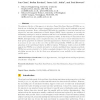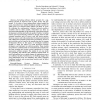11 search results - page 2 / 3 » Explanatory Relations Based on Mathematical Morphology |
ECAI
2010
Springer
13 years 3 months ago
2010
Springer
Bipolarity is an important feature of spatial information, involved in the expression of preferences and constraints about spatial positioning or in pairs of opposite spatial relat...
ATMOS
2011
12 years 5 months ago
2011
The primary objective of this paper is to introduce Fuzzy Rule-Based Systems (FRBSs) as a relatively new technology into airport transportation research, with a special emphasis o...
ICIP
2009
IEEE
13 years 3 months ago
2009
IEEE
In this paper we briefly overview emerging trends in `Adaptive Morphology', i.e. work related to the theory and/or applications of image analysis filters, systems, or algorit...
BMCBI
2008
13 years 5 months ago
2008
Background: The epidermal physiology results from a complex regulated homeostasis of keratinocyte proliferation, differentiation and death and is tightly regulated by a specific p...
IWPC
2010
IEEE
13 years 4 months ago
2010
IEEE
Abstract—Correcting software defects accounts for a significant amount of resources such as time, money and personnel. To be able to focus testing efforts where needed the most,...


